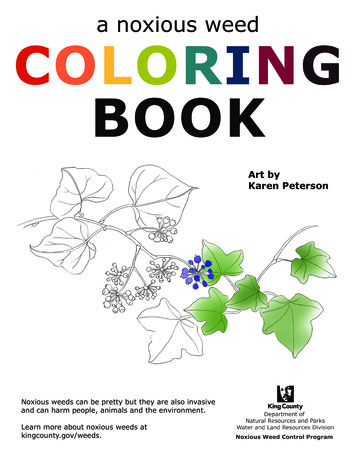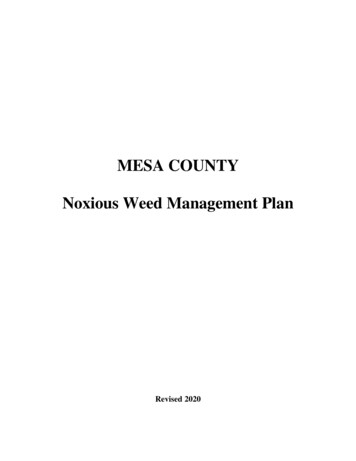
Transcription
a noxious weedCOLORINGBOOKArt byKaren PetersonNoxious weeds can be pretty but they are also invasiveand can harm people, animals and the environment.Learn more about noxious weeds atkingcounty.gov/weeds.
Himalayan blackberry Rubus armeniacusHimalayan blackberry is one of the most common weeds in the Pacific Northwest. It wasoriginally planted for its large, delicious berries. This plant forms dense thickets thatshade out baby trees and make our forests less healthy. The canes can grow up to 40feet long and they can form roots anywhere the cane touches the ground. Plus thosethorns sure hurt!For info about this and other weeds check out our website: kingcounty.gov/weeds
English ivy Hedera helixEnglish ivy is a vine that grows along the ground until it finds a tree or fence or buildingto climb up. The vines can grow 90 feet long and they make trees sick and more likelyto blow over. The dense, evergreen vines also make attractive habitat for rats andother rodents that can spread disease. The black ivy fruits are eaten by birds but arepoisonous to people.For info about this and other weeds check out our website: kingcounty.gov/weeds
Tansy ragwort Jacobaea vulgarisTansy ragwort has cheerful, daisy-like yellow flowers, but it can make horses andlivestock very sick if they eat it. This plant commonly pops up on sunny sites likepastures and the sides of roads. Sometimes you can find cute orange and black Cinnabarcaterpillars feeding on the leaves. The Cinnabar moth is a natural enemy of tansyragwort brought from Europe to help control the weed.For info about this and other weeds check out our website: kingcounty.gov/weeds
Fragrant waterlily Nymphaea odorataFragrant waterlily grows on the surface of lakes and ponds. It escaped from backyardponds where people had planted it because of its pretty, sweet-smelling flowers. Afterthe flowers are pollinated by insects the stem winds up like a spring and draws theflower under the water where it will form a seed. This plant forms thick mats that breedmosquitoes and can even be a danger for swimmers who can get tangled in the stems.For info about this and other weeds check out our website: kingcounty.gov/weeds
Policeman’s helmet Impatiens glanduliferaPoliceman’s helmet gets its common name because its flowers look like Englishpoliceman’s (bobby) helmets. These plants have beautiful, fragrant pink flowers whichis why people planted them in their gardens. But they refuse to stay put where they areplanted. The seedpods explode when touched, shooting seeds up to 20 feet away. Theyspread quickly and crowd out all other plants especially in wet areas like streambanks.For info about this and other weeds check out our website: kingcounty.gov/weeds
Garlic mustard Alliaria petiolataGarlic mustard is only a few feet tall but it has a big impact in forests. This plant takesover forest understories because its roots put out a chemical that prevents other plantsfrom growing. It was originally planted as an edible plant (the leaves taste very stronglylike garlic) but it has quickly spread out of control. Each plant can produce up to 8,000seeds.For info about this and other weeds check out our website: kingcounty.gov/weeds
Purple loosestrife Lythrum salicariaPurple loosestrife likes growing in wet soil like the edges of lakes and in ditches. Peoplehave planted this in their gardens because of the beautiful spikes of purple flowers. But,this plant is really a bully. It spreads quickly in critical natural areas like wetlands andstreambanks and has negative impact on fish and wildlife habitat. Loosestrife beetlescan help control this weed by eating its leaves and flower buds.For info about this and other weeds check out our website: kingcounty.gov/weeds
Giant hogweed Heracleum mantegazzianumGiant hogweed is quite an impressive plant! It grows up to 15 feet tall and has leavesthat can be 5 feet wide. It contains a toxic sap that can cause burns, blisters and evenscars. This usually happens when people are trying to remove the plant, but sometimeshappens when kids play with the large hollow stems. If you see this plant let the KingCounty Noxious Weed Control Program know about it; we will remove it!For info about this and other weeds check out our website: kingcounty.gov/weeds
Garlic mustard is only a few feet tall but it has a big impact in forests. This plant takes . can help control this weed by eating its leaves and flower buds. Purple loosestrife . coloring book, noxious weeds, school, weeds, invasive species, king county, washington, Karen Peterson, art, student, kids, children, educational activities .










